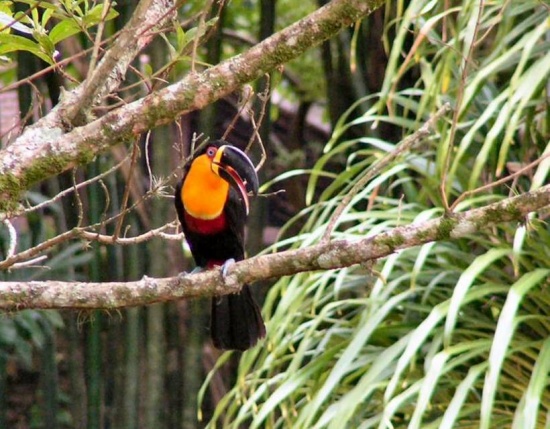
Photo by JWN Andrewes
Rio de Janeiro Botanical Gardens, Brazil, October 2005
- Ramphastos vitellinus
Identification
A medium-large Toucan with a total length of 45-55 cm. (18-22 in). Males are larger and longer-billed than females.
The belly, upperparts, tail and most of the bill are black and the crissum is red.
Variations
There are several subspecies (see Distribution & Taxonomy), most of which differ greatly in the remaining plumage and colour of base and ridge of the large bill:
- Channel-billed Toucan (R. v. vitellinus):
This, the nominate race, has a whitish throat and chest-sides, a large orange spot on the central chest, a relatively broad red band below the chest, red uppertail coverts, a blue base to the bill, and blue skin around the dark brownish eye.
- Yellow-ridged Toucan (R. v. culminatus):
This race has a white throat and chest (sometimes with a very slight yellow tinge), a narrow red band below the chest, yellow upppertail-coverts, a blue to yellow base to the lower mandible, a yellow bill-ridge, bill-tip and base to the upper mandible, and blue skin around the dark brownish eye.
- Citron-throated Toucan (R. v. citreolaemus):
It resembles the Yellow-ridged Toucan, but the chest has a clear yellow tinge, the eyes are pale bluish, and the base of the bill is pale bluish with a narrow orange-yellow band at the very base
- Ariel Toucan (R. v. ariel):
This distinctive race has an orange throat and chest, a broad red band below the chest, red uppertail-coverts, a mainly yellowish base to the bill, and red skin around the pale blue eye.
Except for the Yellow-ridged Toucan, all are easily recognized by a combination of the mainly black bill, the colour of the throat/chest and range.
Similar species
The Yellow-ridged Toucan is easily confused with the very similar Cuvier's Toucan, but can be separated by its smaller size and its proportionally shorter bill with a more keeled culmen. Their voices also differ, with the Yellow-ridged Toucan having a croaking voice similar to other members of the Channel-billed complex, but unlike the yelping voice of Cuvier's Toucan.

Photo by COLOMBIA Birding
Magdalena Valley, Colombia, November 2007
Distribution
It is widespread in tropical South America: found in Venezuela, Guyana, Suriname, French Guiana, Bolivia and Brazil.
Taxonomy
Subspecies
There are 5-6 subspecies[1]:
- R. v. vitellinus in the north-eastern part of its range (north-astern Brazil, the Guianas and eastern Venezuela)
- R. v. culminatus in the western and south-central Amazon (eastern Ecuador, eastern Peru, Northern Bolivia, south-eastern Colombia, south-western Venezuela and western and central Brazil)
- R. v. citreolaemus in north-western South America (Northern Colombia and north-western Venezuela)
- R. v. ariel in the east-central Amazon and disjunctly in coastal eastern Brazil
- R. v. pintoi in south-eastern Brazil (southern Goiás and western São Paulo)
- R. v. theresae in north-eastern Brazil (Piauí and Maranhão)
Previously, the first four of these subspecies were commonly considered four separate species [Gill and Donsker (2010)[2] have R. v. citreolaemus (Citron-throated Toucan) as a separate species]. However, they all interbreed freely where-ever their ranges meet, leading to large areas populated by individuals showing some level of intermediacy between the "true" races. Some of these intermediate populations are sometimes awarded subspecies status (especially pintoi for the population in south-central Brazil and theresae for the population in north-eastern Brazil).
Additionally, while visually very similar, the individuals typically referred to as R. v. ariel in coastal south-eastern Brazil have recently been shown to differ significantly in mitochondrial DNA from R. v. ariel in the east-central Amazon. It is possible the two populations represent two different subspecies, or the population in coastal south-eastern Brazil may even warrant species recognition.
Habitat
Found in various forested habitats, mainly (but not exclusively) humid. Mainly in lowlands, but locally to an altitude of 1700 m (5600 ft). It is generally fairly common.
Behaviour
It is submissive to the larger White-throated Toucan and Toco Toucan.
Diet
Omnivorious and highly opportunistic. Food includes various fruits, insects, reptiles and small birds (mainly nestlings).
Breeding
Breeding is largely seasonal, but exact timing differs between regions. The 2-4 eggs are placed in a tree cavity. Both sexes participate in the incubation of the eggs and feeding of the chicks.
Vocalisation
Channel-billed Toucans with Boat-billed Flycatcher
Recording by Andrew Whitehouse, Regua, Brazil, September 2008
References
- Clements, J. F., T. S. Schulenberg, M. J. Iliff, D. Roberson, T. A. Fredericks, B. L. Sullivan, and C. L. Wood. 2016. The eBird/Clements checklist of birds of the world: v2016, with updates to August 2016. Downloaded from http://www.birds.cornell.edu/clementschecklist/download/
- Gill, F and D Donsker (Eds). 2010. IOC World Bird Names (version 2.7). Available at http://www.worldbirdnames.org/.
- Avibase
Recommended Citation
- BirdForum Opus contributors. (2025) Channel-billed Toucan. In: BirdForum, the forum for wild birds and birding. Retrieved 26 April 2025 from https://www.birdforum.net/opus/Channel-billed_Toucan
External Links
GSearch checked for 2020 platform.1






